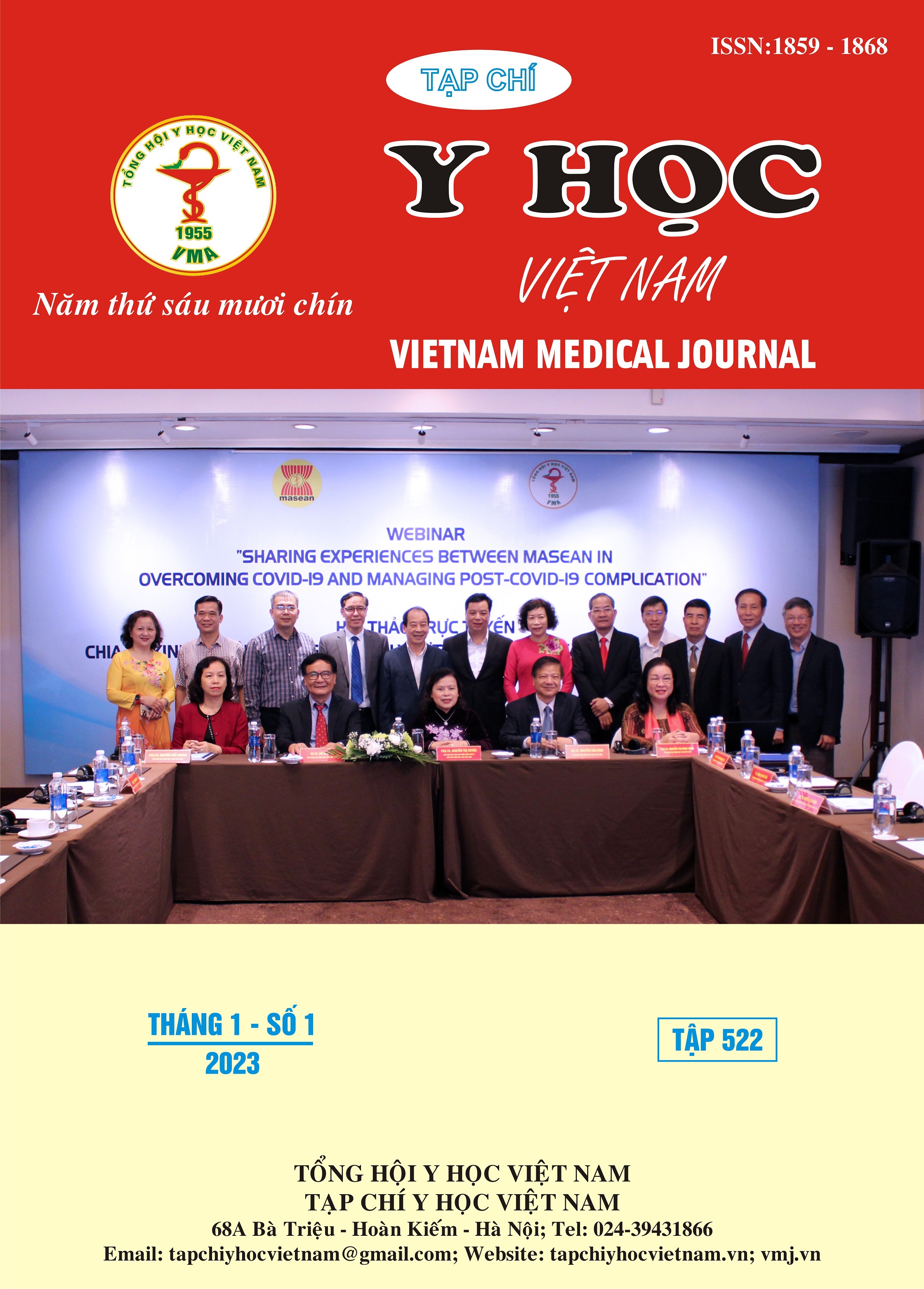ĐẶC ĐIỂM LÂM SÀNG, HÌNH ẢNH HỌC VÀ KẾT QUẢ ĐIỀU TRỊ NGƯỜI BỆNH NHỒI MÁU NÃO DO TẮC ĐỘNG MẠCH NÃO GIỮA ĐOẠN M2
Nội dung chính của bài viết
Tóm tắt
Mục tiêu: Tìm hiểu đặc điểm lâm sàng, hình ảnh học và kết quả điều trị nhồi máu não cấp do tắc động mạch não giữa đoạn M2 tại Trung tâm Đột Quỵ bệnh viện Bạch Mai. Phương pháp nghiên cứu: Nghiên cứu mô tả. Đối tượng nghiên cứu là những người bệnh được chẩn đoán xác định nhồi máu não cấp do tắc động mạch não giữa đoạn M2, điều trị tại Trung tâm Đột Quỵ Bệnh viện Bạch Mai từ tháng 1/2021 đến tháng 5/2022. Chúng tôi theo dõi và đánh giá điểm NIHSS tại thời điểm 24 giờ sau điều trị và điểm mRS tại thời điểm sau 90 ngày điều trị. Kết quả: Tổng số đối tượng nghiên cứu là 105 người bệnh, tỷ lệ nam/nữ = 1,1/1. Tuổi trung bình: 68,0 ± 12,4, nhóm tuổi 70 - 79 chiếm tỷ lệ lớn nhất 31%. Số người bệnh nhập viện trước 4,5 giờ đầu sau khởi phát chiếm tỷ lệ lớn nhất 49,5%. Thời gian từ lúc nhập viện đến được dùng thuốc tiêu sợi huyết trung bình 39,5 ± 22,1 phút, thời gian từ khi nhập viện đến khi lấy huyết khối trung bình là 110,6 ± 63,5 phút. Phân loại theo TOAST, nguyên nhân mạch máu lớn chiếm tỷ lệ cao nhất 55,2%, thuyên tắc mạch từ tim chiếm tỷ lệ cao 20%. Tại thời điểm ra viện 90 ngày, bệnh nhân điều trị tái tưới máu phục hồi tốt có điểm mRS 0-2 chiếm 59,7%, tỷ lệ chảy máu nội sọ có triệu chứng chiếm 8%. Kết luận: Nghiên cứu những người bệnh nhồi máu não do tắc động mạch não giữa đoạn M2 được tái tưới máu tại Trung tâm Đột quỵ Bệnh viện Bạch Mai từ tháng 1/2021 đến tháng 5/2022 cho thấy tỷ lệ hồi phục tốt. Việc điều trị tái tưới máu đã cải thiện NIHSS 24 giờ sau điều trị và MRS sau 90 ngày so với nhóm điều trị nội khoa tối ưu, khác biệt có ý nghĩa thống kê. Tuy nhiên, tỷ lệ chảy máu có triệu chứng còn cao.
Chi tiết bài viết
Tài liệu tham khảo
2. Hernández-Pérez M, Pérez de la Ossa N, Aleu A, et al. Natural history of acute stroke due to occlusion of the middle cerebral artery and intracranial internal carotid artery. J Neuroimaging. 2014;24(4):354-358. doi:10.1111 /jon.12062
3. Goyal M, Menon B, Zwam WV, et al. Endovascular thrombectomy after large-vessel ischaemic stroke: a meta-analysis of individual patient data from five randomised trials. undefined. 2016. /paper/Endovascular-thrombectomy-after-large-vessel-a-of-Goyal-Menon/28ed2f84063132431b7a625fb786e5bb0d6e2bf3/figure/1. Accessed June 15, 2021.
4. Kim CH, Kim SE, Jeon JP. Meta-Analysis of Endovascular Treatment for Acute M2 Occlusion. J Korean Neurosurg Soc. 2019;62(2):193-200. doi:10.3340/jkns.2017.0299
5. Phan K, Maingard J, Kok HK, et al. Contact Aspiration versus Stent-Retriever Thrombectomy for Distal Middle Cerebral Artery Occlusions in Acute Ischemic Stroke: Meta-Analysis. Neurointervention. 2018;13(2):100-109. doi:10.5469/neuroint.2018.00997
6. Atchaneeyasakul K, Malik AM, Yavagal DR, et al. Thrombectomy Outcomes in Acute Ischemic Stroke due to Middle Cerebral Artery M2 Occlusion with Stent Retriever versus Aspiration: A Multicenter Experience. Interv Neurol. 2020;8(2-6):180-186. doi:10.1159/000500198
7. Havenon A de, Narata AP, Amelot A, et al. Benefit of endovascular thrombectomy for M2 middle cerebral artery occlusion in the ARISE II study. Journal of NeuroInterventional Surgery. 2021;13(9):779-783. doi:10.1136/neurintsurg-2020 -016427
8. Gory B, Lapergue B, Blanc R, et al. Contact Aspiration Versus Stent Retriever in Patients With Acute Ischemic Stroke With M2 Occlusion in the ASTER Randomized Trial (Contact Aspiration Versus Stent Retriever for Successful Revascularization). Stroke. 2018;49(2):461-464. doi:10.1161/STROKEAHA.117.019598


